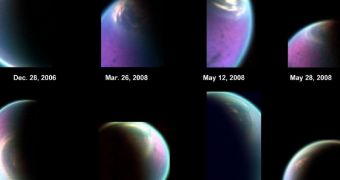Over the past couple of years or so, a large volume of scientific papers covering various aspects of Saturn's largest moon, Titan, have been published. These data are currently helping researchers form an integrated view of what this celestial body is all about.
Many of the research papers dealing with Titan are based on data collected by the NASA Cassini orbiter, which has been analyzing Saturn, its ring system and its moons since achieving orbital insertion around the gas giant, on July 1, 2004.
Since that time, Cassini carried out numerous flybys of this amazing moon, which is very similar to our own planet. In fact, it is the most Earth-like object in the entire solar system, even when taking the massive temperature difference into account.
One of the main directions of research while studying Titan today is to figure out how the moon changes with seasons. Data collected by NASA revealed that the object goes through what could best be described as “mood changes” every season.
But more recent information compiled by Cassini reveals that the moon may also be experiencing daily variations. These changes are most likely the product of a series of processes that we don't yet fully understand, or don't even know exist.
Data of how the celestial body looks like during these variations were published in “Titan through Time,” a special issue of the esteemed journal Planetary and Space Science. “As a whole, these papers give us some new pieces in the jigsaw puzzle that is Titan,” Conor Nixon explains.
The investigator holds an appointment as a scientist with the Cassini team. He is based at the NASA Goddard Space Flight Center (GSFC), in Greenbelt, Maryland. He co-edited the special journal issue with Johns Hopkins University Applied Physics Laboratory (JHU-APL) expert Ralph Lorenz.
The new maps “show us in detail how Titan's atmosphere and surface behave like Earth's – with clouds, rainfall, river valleys and lakes. They show us that the seasons change, too, on Titan, although in unexpected ways,” Nixon goes on to say.
“Snapshot by snapshot, these images give Cassini scientists concrete evidence that Titan's atmosphere changes with the seasons. We can't wait to see more of the surface, in particular in the northern land of lakes and seas,” Cassini team associate and University of Nantes expert Stephane Le Mouelic concludes.

 14 DAY TRIAL //
14 DAY TRIAL //